As I mentioned that morning, on Wednesday Mr Bugg and I had an outing to Jordan Lake, seeing what kind of activity was about as spring peeked in. Granted, it seems way too early for spring, and it is, but it didn’t feel that way, and the first signs were there. This post will all be about birds – with one exception, just for balance.
Things started slow. The rampant activity that I’d seen on the visit just over a week earlier wasn’t to be found, possibly because the boaters were out in force, which made the lake stink like a petroleum refinery at times. Seriously, way too many people need help tuning their outboard engines, because the smell of unburnt gasoline was overpowering even as the damn things cruised past 200 meters away – I used to live in south Jersey before stronger EPA regulations and I know this stench well. It took nearly a half-hour before we got a decent view of a red-headed woodpecker (Melanerpes erythrocephalus,) who was remaining silent and mostly flitting back and forth on just one tree: fly out for a few meters, bank hard, and return to the same stump. I’m not sure what that was, but I suspect it was something habitual.

Then again, as I look at this image, it occurs to me that the woodpecker may simply have found a swarm of insects, and was thus flying through it to snag snacks, which it was kind (or smug) enough to show off here. We can also see that it’s a yearling, the last vestiges of grey head feathers still visible in patches. A little later on we got barely good enough looks at an adult, not far off, with a uniformly bright red head. But for the most part it was notably slow in this spot. This might only have been due to the time of day – either way, we moved on to other areas.

The entire region is rife with black vultures (Coragyps atratus,) but they don’t always pose so prominently against the sky while in close range, so…

Between the season and the warmth of the day, several songbird species were present, but hyperactively flitting through the undergrowth. A ruby-crowned kinglet refused to let me get a sharp and unobscured photo, but this black-capped chickadee (Poecile atricapillus) posed on a stump before foraging through the seed pods of an American sweetgum (Liquidambar styraciflua.) Chickadees, while just as twitchy as most songbirds, at least tend to pause more often in open view, probably from ego. This one was gorging itself on seeds and soon adopted a typical position, hanging upside-down from the pod while digging out the seeds within. I’ve been trying to get a decent photo of this for a while now, but have few, if any, and this day was no exception.
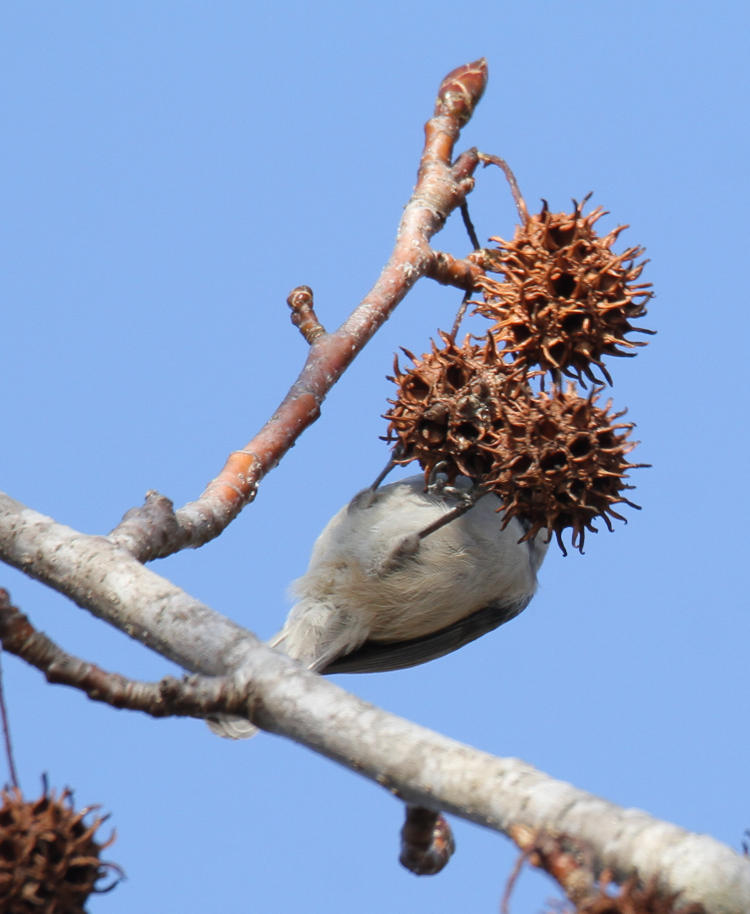
Nice angle, good lighting, close enough for sharp photos, and the chickadee did nothing but moon me. Oh yeah – it knew.
[By the way, compare the sky color of these images with the vulture above them. These were all taken within five minutes, not more than 15 meters apart, just aiming at the sky slightly differently – it changes that much, and more, with angle.]
We’ll take a look at a wider crop of the same image for something that I found while editing.

See the white streak over to the right, with the brown smudge in the sky? Yeah, just a spiderweb and occupant, with but one strand finding the right angle to reflect the sunlight down to me. I’d say this was the first spider I’d photographed this year, but it’s not. Plus the beach areas were literally crawling with some wolf-like species that I never bothered to macro-ize. Yes that’s a word.
But that was about it for this area, too, and another further on yielded nothing, so we drove a short distance away to another frequent haunt, just to see what might be found there. This one is far more hit-or-miss – we’ve been out there when it’s bursting with activity, and also when there’s absolutely nothing to be seen but distant seagulls. It initially looked like it would be the latter case, but then I spotted something in the distance. And shortly thereafter, another.
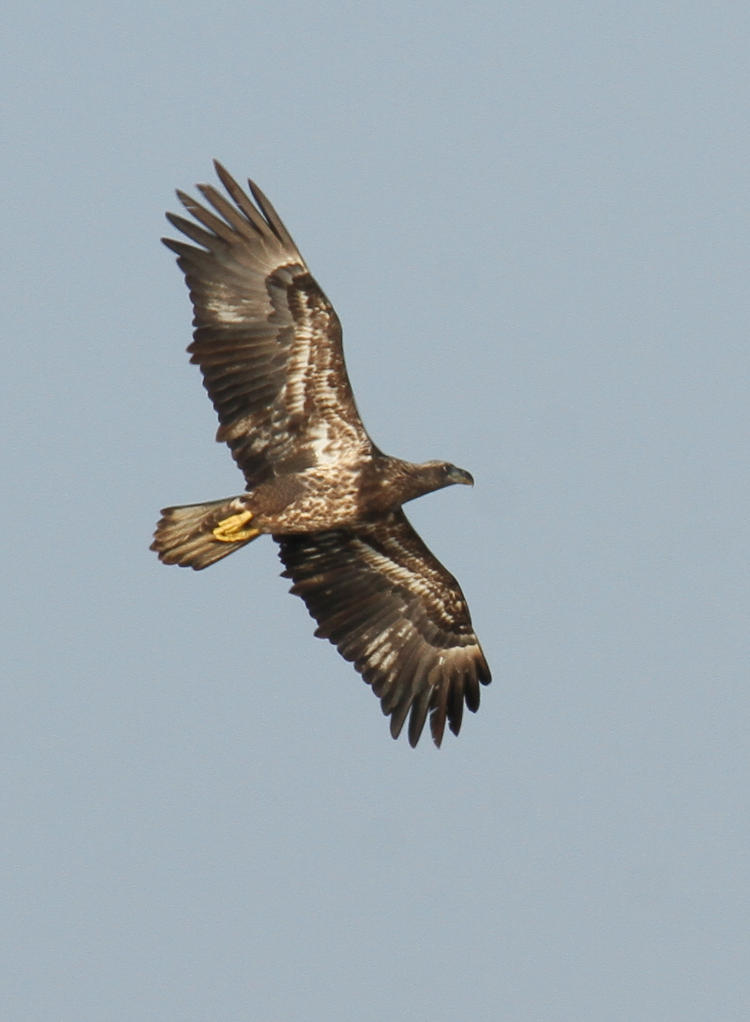
They were quite some distance away so all of these images are cropped tight, but the bald eagles (Haliaeetus leucocephalus) were distinctly in evidence. This image was not the first seen, which was an adult and even more distant; this one is a second-year immature, and was kind enough to do a bit of hunting straight out from where we stood. Within a couple of minutes, another joined in, perhaps staying just a bit farther out, but not significantly.
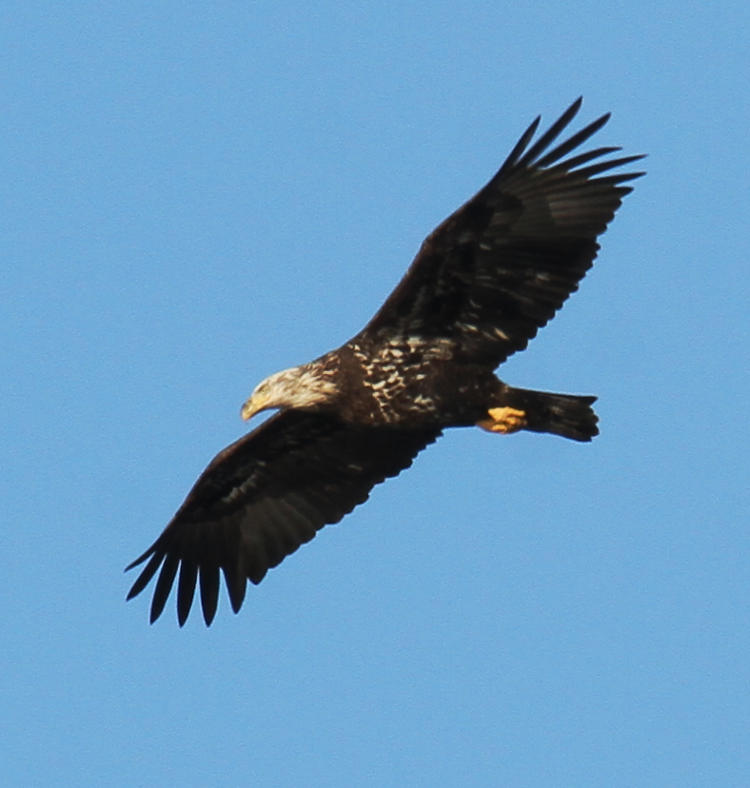
This is a third-year eagle; next year this one will develop the uniformly brown body and wings with the classic white head and tail.
While perhaps not the most active time of day to see the species, we had the right conditions with the sun dropping lower in the sky in late afternoon, behind us, and so illuminating the undersides frequently when they were circling; plenty of other light and viewing angles, including early morning right where we were, would have made things much more difficult. It’s often not just about finding an area with active wildlife, but a good enough view of them as well.

The two-year-old was on the hunt, and we watched it several times as it suddenly changed its lazy circling into a more deliberate descending curve or spiral. Osprey will simply slam into the water, taking off from floating on their bellies with their captures clasped firmly in talons, but eagles tend to do a flying grab, skimming at high speed over the surface and snagging the fish in passing. This is likely because of their weight, and how much effort it would take to rise out of the water again, especially when the surface prevents dropping the wings below ‘level.’

This sequence, however, annoys me. Because I got tired of autofocus suddenly finding the background horizon far more compelling, I’d switched to manual focus, which is iffy sometimes with distant subjects because the viewfinder won’t resolve tight enough for me to be sure. But I never tweaked focus during this descent, so why the hell does focus seem to be wandering? I have to put it down to either camera shake or the image stabilizer moving at the wrong time, or both, but it certainly didn’t help the results at all.
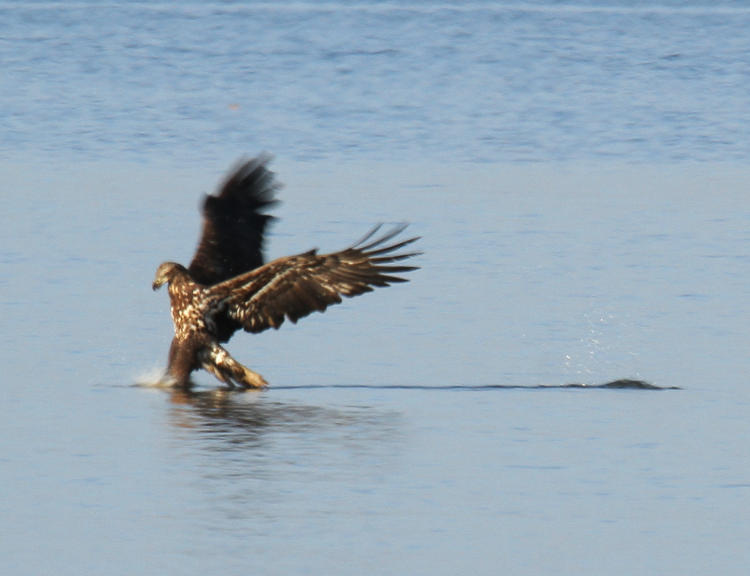
I tweaked the contrast a little on this one to make a particular detail stand out: notice the droplets still in the air, well behind the eagle, from making contact with the water. This gives an idea of how fast the eagle was moving as it made its capture.
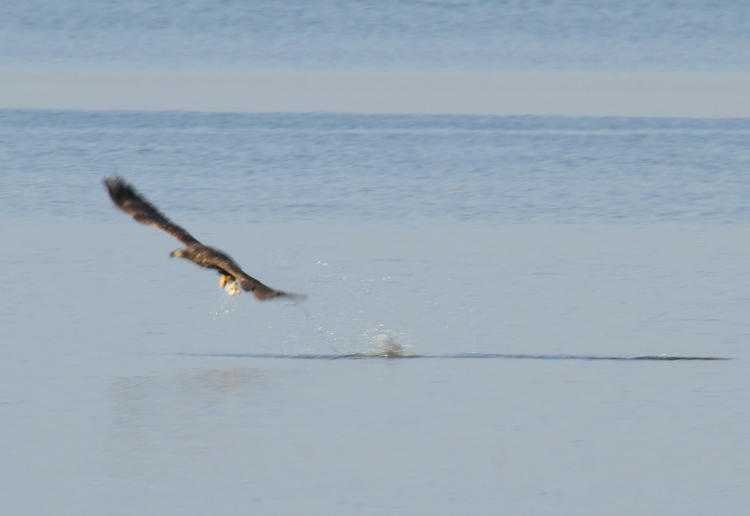
And it rises again, still showing a long wake trail. But shitty sharpness.
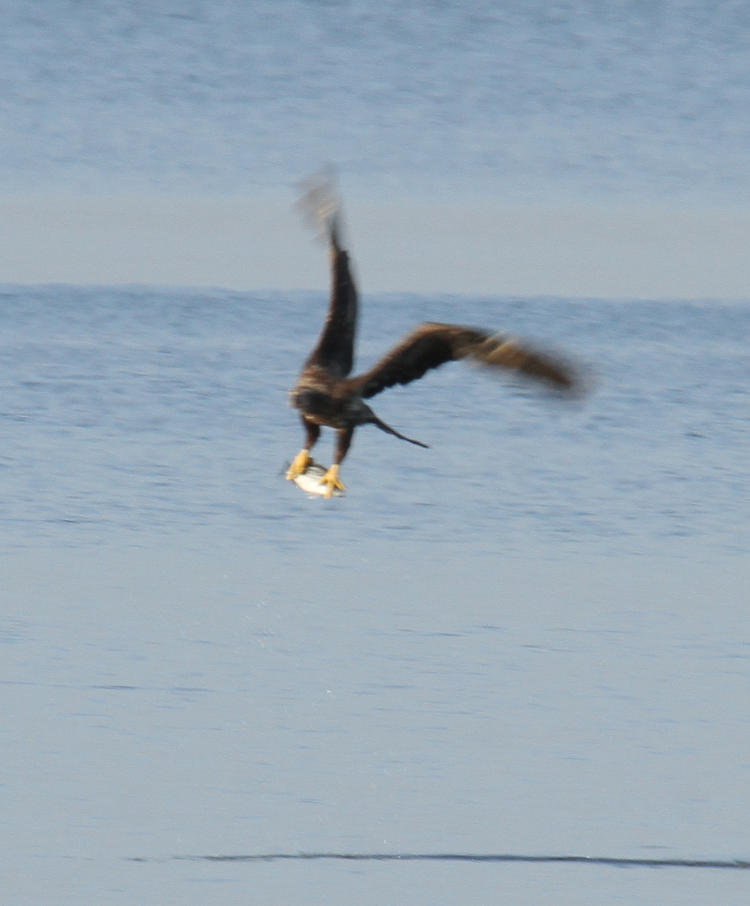
This is even worse, though I’m quite sure it was largely due to motion, but this illustrates clearly that a fish was in hand, at least. We’ll take a look at the full frame for more illustration:
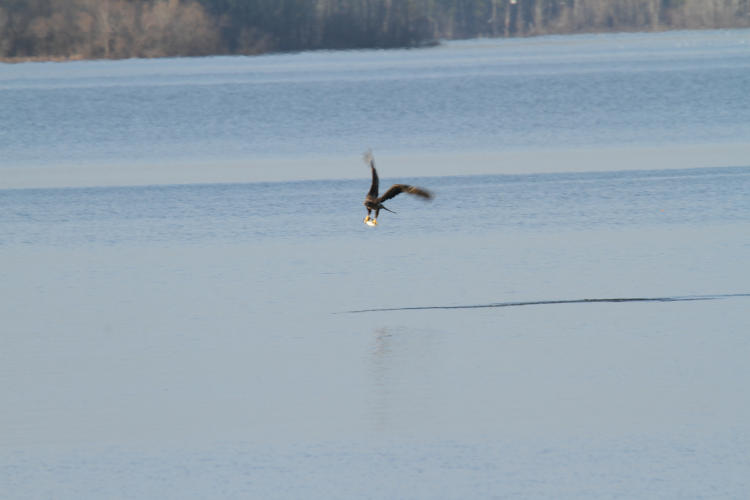
Reduce this down to viewfinder size, and speckle it a bit because of the ground glass focusing screen, and you’ll understand, perhaps, why manual focusing on this subject wasn’t giving me bang-on results.
This was exactly the kind of subject that I was after for video tests, especially with the hot-shoe sight, but we were on a student outing with a lot of hiking and I wasn’t in the mood to lug around the heavy tripod and gimbal head. Plus I know Fate – we’re on a first-name basis – and being prepared is the surest way of not seeing a damn thing. It’ll happen one of these days, but not before I get enough failures under my belt first. That probably wasn’t the best way to phrase that…
The third-year eagle gave up hunting and took a perch not far away, as it neared sunset, though the perch was abandoned when a noisy boat came past a little too closely.

This is another full-frame image, and knowing where I was standing and the island that the eagle was on, I could measure the distance in Google Earth and give a better idea of the distances involved. This was at 600mm focal length, and the eagle was 350 meters off, give or take 20.
So, not a bad outing for February, and while I certainly would have liked many of the images to be better, I at least got a few keepers in the slow season and enjoyed the weather. And yeah, I mentioned a non-bird photo up there, so let’s see someone else enjoying the weather:
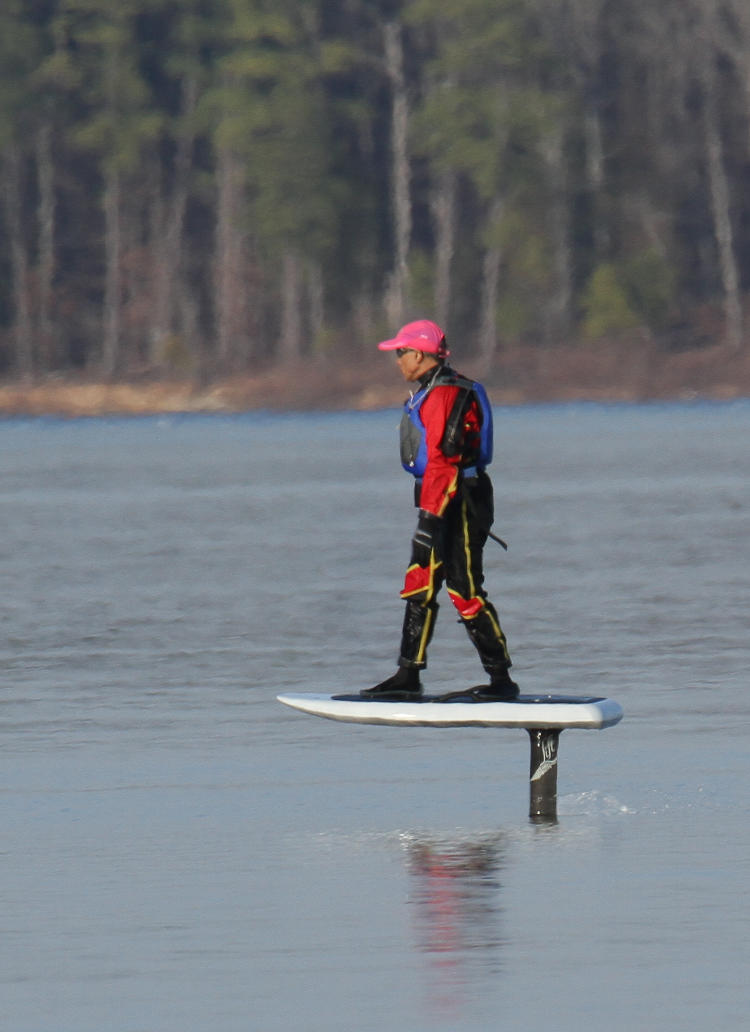
This is the second one I’ve seen on the lake, and they look like an absolute blast. This is a electrically-powered hydrofoil surfboard, like those seen here. The subsurface wing raises the board above the water at speed and provides a perfectly smooth ride, free of the chop from the water’s surface, and it’s pretty fast and totally silent. I’m beyond the age when I’d make the most out of it, plus the cost is prohibitive, and can they even hold a tripod? But yeah, if someone offers me a test ride on one, I ain’t saying no…



















































